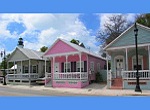Green Home Construction Provides Lasting, Pretty Housing
Last Updated: July 4, 2025
Green home construction might be close to an oxymoron for some of us in the community development field. The greenest thing to do would be to find an older home in an established neighborhood and retrofit it to suit your needs. The advantages of housing renovation include re-use of infrastructure and materials, as well as the fact that the home doesn't add to sprawl.

After all, if you want to be green, you could add some solar energy projects to an existing home, couldn't you?
OK, we will give up and recognize that you came to this page because you are determined to build a new home. In truth, this may be well justified in areas that are growing in population, and certainly construction of more housing may help to decrease the ridiculously high housing prices that are causing hardship in some cities and regions.
The good news is that you can build a wonderful solar-powered home in cities and suburbs, as well as going "off the grid" in rural areas. Or in some places it will be wind or biomass (a catch-all phrase for converting a biological material into energy) that power the house.
Green Home Construction Criteria
Currently the U.S. Green Building Council is the industry association in the forefront of green construction practices in America. They offer a certification called LEED®, although other green certifications exist. For the homeowner, certifications would be fluff; you're looking for results in the form of low energy buildings, low allergies, low impact on the earth and climate, and high performance.
In fact the latest International Green Construction Code was published in 2021, and we're expecting that this relatively new overlay code (meaning it "sits on top of" but does not replace any other type of older code) will continue to make green building practices more widespread. This particular code benefits from collaboration with an impressive variety of industry groups that interface somehow with green home building.
However, let's use LEED as a reference. Some of its categories for green home construction include: site selection, water efficiency, materials and resources, energy and atmosphere, indoor environmental quality, and location and linkages to important destinations.
Site Selection and Energy Generation for Your Home
Contribute substantially to lower energy bills through good site selection, whether choosing to install an active solar system (one that generates power) or using passive solar techniques that orient the house so that it naturally picks up less heat in the summer and more in the winter.
You may add generation capabilities at a modest or grand scale during green home construction. Solar shingles, panels, and collectors of various types are now being installed routinely. If an entire housing development is involved, this becomes even more attractive from a cost-benefit standpoint, particularly when installed on top of community facilities such as clubhouses, or over large parking lots.
States are requiring that utility companies have a way to let your meter run backward. In other words, you may be able to sell your surplus electricity generated in your new home back to the electric company and to the grid at the same rate that it costs the utility to generate its own power.
If you plan to build active or passive solar in a subdivision, obviously this consideration should dominate your choice of lots.
For active solar power, consult a professional as early as possible.
If you would like passive solar help, you should be able to find a local extension agent or university expert to help you with this topic. Magazines and websites can assist you as well.
Be sure to investigate whether any local electricity generation you plan, such as active solar or wind, will be allowed under the zoning ordinance.
Also investigate the potential for neighboring lots to impact your solar access. Will you be able to guarantee the setbacks you need to gain solar access? Usually setbacks from your own lot line and that of your neighbors are governed by the zoning ordinance also. Increasingly municipal zoning is taking solar into account in smart ways, but it never hurts to check.
Wind for a single-family home is hard to promote to the neighborhood, unless you're in a semi-rural environment. (See our discussion of wind turbine zoning.)
Geothermal energy is very practical in many climates, and can both heat and cool your home. Installation cost is high, but total life-cycle cost is economical. You'll find your heating and cooling bills to be extremely reasonable, particularly if you live in a location where both are expensive on a seasonal basis. Certainly geothermal technology is earth-friendly.
If you investigate solar, wind, geothermal, and other alternative energy methods, and you can't bring yourself to accept the up-front cost or the unproven technologies, many electric companies allow you to purchase electricity from green sources, at a slightly higher price.
Location and Linkages for Green Housing
Another site selection topic in my opinion is what LEED calls location and linkages. The closer your site to your everyday shopping needs, schools, places of worship, and habitual recreational activities, the better.
You'll conserve energy and decrease your carbon footprint through less driving.
Consider also proximity to dedicated biking paths, and try to locate your green home in a walkable community. You can install all the latest bells and whistles in terms of sustainable building products and green energy, but if you locate this home on a parcel of land that necessitates driving everywhere, we would argue you really aren't being very green at all.
In the case of a small or large development of green homes, you also may wish to consider whether the site is suitable in case you want to start a community garden.
How far is your solid waste hauled? Are there good recycling opportunities, or does your waste pretty much have to end up in the landfill if you don't re-use it?
Community Water Efficiency
In green home construction, there are many opportunities to install low water usage appliances and fixtures. These include the washer, dishwasher, shower, and toilet. Hot water heaters of the on-demand variety cost plenty at the outset, but use less energy.
And what becomes of the stormwater that pours off of your roof? If you want to be green, capture it in rain barrels instead of quickly diverting it away from your property. The barrels then can be tapped as sources of water for landscaping.
For larger storage capacity, use a cistern. Or simply plant a rain garden at the end of the guttering, although you'll want to pipe the stormwater a little further from your foundation than normal. All of these things need to be planned before you commit to a particular site plan.
Is that native xeriscape (landscape requiring little to no watering) you plan for your total lawn acceptable, or does the zoning ordinance specify a minimum percentage of turf grass? Be sure to select plantings that are as drought tolerant as possible. These will use less water in all situations and be resilient in climate extremes.
All of these measures that can be taken by individual households in many societies really add up to community water efficiency. That shouldn't be underestimated, as the infrastructure to provide potable water and to handle stormwater in a way that doesn't promote flooding or disease are needed in every part of the world.
Green Building Materials
Material choice is an extremely important element in green home construction. Self-promotional product information abounds, so we’ll make it simple.
In general, choose materials on the basis of the expected life span, the transportation cost of moving the material to the site, implications for energy usage and health damage. Minimize the need for water usage. Use recycled materials where they make environmental sense.
Another general factor is whether the materials you wish to use meet the local building code. This is more likely if the community has adopted an energy conservation code.
Here are some major points:
- Wood. Consider both the length of time it took to grow the wood (and therefore the length of time it would take to re-grow the wood you cause to be cut) and the distance the wood has to be transported to reach you. Bamboo is popular now as a green solution because it's extremely fast-growing. However, many bamboo products are grown far away, so factor that in as well.
- Walls. While all wall types offer advantages and disadvantages, a particularly promising technique is the ICF wall, or insulating concrete forms wall. The "forms" or molds for the concrete are made of an insulating plastic foam product, and then concrete is poured into the middle of the form. Reinforcement bars also are placed in the concrete. The result is a quite thick wall, very well insulated, and therefore quiet too. Heating and cooling therefore becomes very efficient.
- Windows. EnergyStar windows still save you a ton of money on heating and cooling. Check into purchasing the very best performing windows that you can afford. This is an area where the marketing hype often becomes extreme, so sort through the information you gather carefully.
- Stone. Transporting stone is quite expensive, so use stone native to your area whenever possible, or attempt to find stone to re-use from buildings being demolished.
- Carpeting. There are many attractive carpets made from recycled plastics right now. If you can't find a recycled product you like, at least think of the life cycle and buy wool. Bamboo can be woven into carpeting that's surprisingly soft. Check into how the various products are cleaned and their projected life spans too. Like all building products, learn how close to home the carpeting is made.
- Flooring. If you want wood floors, bamboo and cork are friendly choices for green home construction.
- Brick. Brick can be a "green" product if the clays are extracted locally and the brick is formed nearby. In many climates you will simply want to insulate between the brick and the drywall. That carries its own complications, but ask a good builder.
- Drywall. Alternatives to gypsum board, the manufacture of which is quite polluting, are being produced constantly. Investigate what is available if you are serious about green home construction.
- Cabinets. Many cabinets and other building elements on the market today still have formaldehyde in them. Do you really want to live with that? Very attractive cabinets can be made from bamboo and other fast-growing woods. Incidentally, I've seen some gorgeous countertops made of recycled newspaper, and a recycled glass counter stunned with color in another home.
- Paint. Many paints give off VOC's (volatile organic chemicals) for as much as six months after they are applied. You can find low-VOC or no-VOC paints and make your new green home construction much safer.
- Shingles. Several alternative materials exist, and in particular, you might want to investigate solar shingles. Also if you're in a warmer climate, definitely choose a lighter shingle color as a no-cost way to decrease your air conditioning bill and increase your comfort. You might see this described as the white roof movement. Conversely, if you live in a cold place, darker shingles are your best choice. If you really want to be in the forefront, you could investigate a green roof for a portion of the home, where you grow live plants. These are also called living roofs.
- Appliances. Since many of us use electricity that is generated through a carbon source, the less electricity we need, the better. The same applies to natural gas. So when it comes time for buying a water heater, investigate the life cycle cost of a tankless water heater compared to the conventional sort. Look for the Energy Star appliance ratings on all appliances. Pay particular attention to lighting, heating, and cooling efficiency. And on that more profound note, consider whether you really need electricity for some tasks at all. Do you need an electric can opener? Probably you do not.
- Thermostats. Programmable versions of all types are very widely available and cost little extra. Some homeowners will like versions they can control from their smartphones if their lives don't necessarily follow the same trajectory every week day.
- Lawn. Think seriously about not having one! Maybe you can find other plants that don’t require as much maintenance, water, and fertilizer. Rock, fountains, native grasses that don't grow much, and ground cover are great alternatives. Work with plants native to your area when you can, because they grow deeper roots and are healthier for the neighborhood. If you want a giant patio or deck, consider permeable pavers instead.
If you do have a lawn, follow one of the best lifestyle decisions I've made recently: buy a battery-powered mower. They are so much quieter, burn no gasoline, start whether it's warm or cold, start more easily, are lighter weight and less tiring to use, and I don't have a headache because I followed a gasoline-powered engine on a hot day.
And seriously, the world won't come to an end if you don't have the best lawn on the block, so forget the fertilizer entirely, or at least skip it every other year.
Composite fencing resembling wood fence may or may not be more environmentally friendly than wood fencing; investigate the particular product carefully.
Find a Contractor Who Appreciates Green Home Construction
This brings us to finding a builder who ideally is experienced in green home construction. If you cannot find one, at least find someone who is interested and motivated. A skeptical builder will foil your every attempt, or at least give you so much grief you will be inclined to scrap the whole idea of building a new home.
So the experienced builder will be able to explain the various solar options to you. Of course solar viability varies across the country; some places simply have more sunny days than others.
It pays to do your own research as well, as new products are coming on the market all the time. Consider carefully whether you want to be the guinea pig for a new product; my rule of thumb would be to experiment in smaller items and to stick with a more proven technology for major systems.
How Much House Is Enough?
Arguably the most important point about green home construction is the obvious one that seems to be so frequently overlooked in the current frenzy about sustainability topics. Do you really need a 5,000 square foot house? Do you need a one acre lot, and three bathrooms for two of you?
The green project that will impress me is the one that is the right size for the household in question, and not a square inch more. Recycling, locating, and transporting materials aren't free, so don't consume more than you need. That will go a long way toward green living.
Consider larger questions of consumption as well. Do you really need that extra bathroom? Do you really need to take such a long shower? And does anyone really need a home swimming pool or hot tub? You might "need" a pool if you use it every day, but I see pools that are used about six times a season and therefore can't be much more than a status symbol.
The Future of Green Home Construction
Knowledge about green home construction is proliferating rapidly. In Europe aggressive EU energy and greenhouse gas policies are pushing innovation in energy-efficient building practices. The state of New York has started a green home construction program, and a California initiative is in place. Coastal states in general are in motion about climate change and all things green.
This is an evolving subject where it pays to do your research, including learning about new construction techniques and checking into state, local, and federal incentives for green home construction.
More Pages Relevant to Green Homes
- Making and Keeping a Good Community >
- Housing Issues > Green Home Construction
Join GOOD COMMUNITY PLUS, which provides you monthly with short features or tips about timely topics for neighborhoods, towns and cities, community organizations, and rural or small town environments. Unsubscribe any time. Give it a try.




